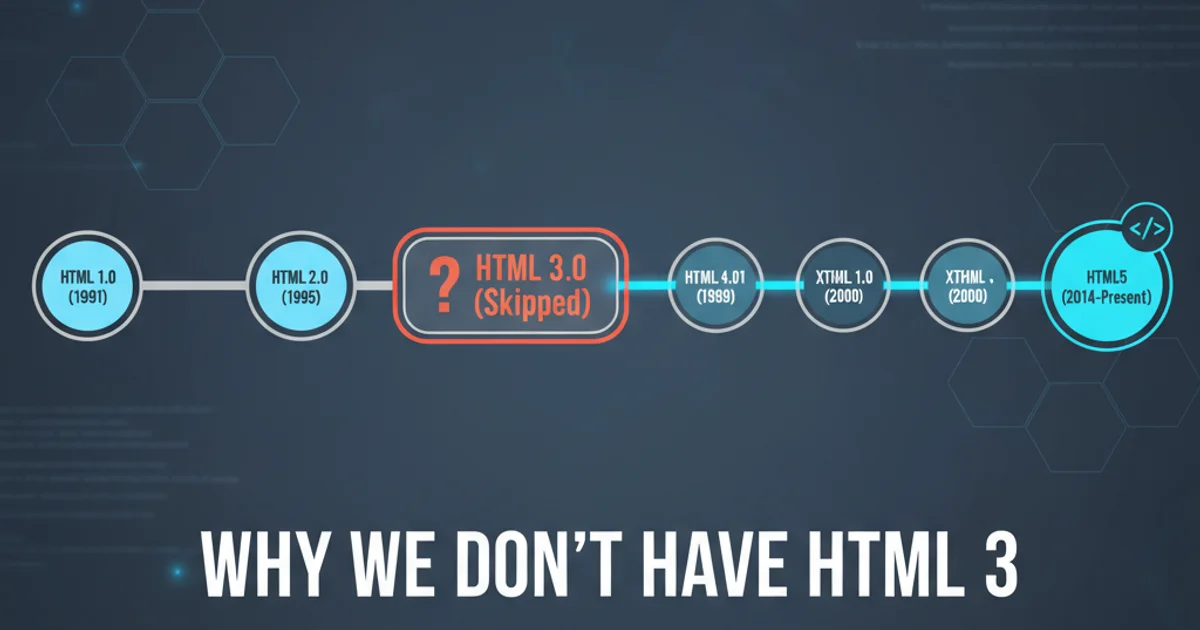Why we don't have HTML 3
Categories:
The Missing Link: Why We Don't Have an HTML 3.0

Explore the historical context and technical evolution that led to the skipping of HTML 3.0, diving into the challenges and innovations that shaped the web's foundational language.
When discussing web standards, you'll often hear about HTML 2.0, HTML 4.01, and then HTML5. But what happened to HTML 3.0? This article delves into the fascinating, albeit sometimes chaotic, history of HTML development, explaining why a formal HTML 3.0 specification never saw the light of day, and how its absence ultimately paved the way for more robust and flexible web technologies.
The Ambitious Vision of HTML 3.0 (aka HTML 3.2)
In the mid-1990s, as the web began its rapid expansion, there was a clear need to extend HTML's capabilities beyond its initial document-centric design. HTML 2.0, standardized in 1995, provided a solid foundation but lacked features necessary for dynamic, interactive, and visually rich web pages. The World Wide Web Consortium (W3C), formed in 1994, took on the task of evolving HTML. Their initial efforts led to a working draft known as HTML 3.0, which was later refined and published as HTML 3.2 in 1997.
HTML 3.0 was an ambitious proposal, aiming to introduce a wealth of new features, including tables, applets, text flow around images, subscripts and superscripts, and more sophisticated form controls. However, its development coincided with the browser wars between Netscape Navigator and Microsoft Internet Explorer, where proprietary extensions often outpaced official standardization efforts. This created a fragmented landscape, making it difficult for a comprehensive, unified HTML 3.0 to gain traction.
flowchart TD
A[HTML 2.0 (1995)] --> B{Need for Advanced Features}
B --> C[W3C Drafts HTML 3.0 (1995)]
C --> D{Browser Wars & Proprietary Extensions}
D --> E[HTML 3.0 Stalls]
E --> F[W3C Publishes HTML 3.2 (1997)]
F --> G[Focus Shifts to HTML 4.0 (1997)]
G --> H[XHTML 1.0 (2000)]
H --> I[HTML5 (2014)]
D --"Introduces non-standard tags"--> FEvolutionary path of HTML, highlighting the HTML 3.0/3.2 period.
The Rise of HTML 3.2 and the Shift to HTML 4.0
Recognizing the challenges of getting a full HTML 3.0 adopted amidst the rapid pace of browser innovation, the W3C decided to take a more pragmatic approach. Instead of pushing the full HTML 3.0 specification, they released HTML 3.2 as a W3C Recommendation in January 1997. HTML 3.2 was essentially a cleaned-up version of HTML 2.0, incorporating many of the widely adopted features from the HTML 3.0 draft and popular browser extensions, such as tables, applets, and text flow around images. It was designed to reflect the 'common ground' of HTML features supported by browsers at the time.
Almost immediately after HTML 3.2's release, the W3C began work on HTML 4.0. This rapid transition indicated a strategic shift. Rather than incrementally building on a stalled 3.0, the W3C aimed to create a more robust, extensible, and internationally-friendly standard that could better accommodate the web's future. HTML 4.0, released in December 1997, introduced crucial concepts like style sheets (CSS), scripting (JavaScript), frames, and improved accessibility features, fundamentally changing how web pages were structured and styled. This effectively bypassed the need for a distinct HTML 3.0, as 4.0 absorbed and expanded upon its core ideas.
Lessons Learned: The Impact on Web Standards
The story of HTML 3.0 is a testament to the dynamic and often messy process of standardizing rapidly evolving technologies. The 'missing' version highlights several key lessons:
- Pace of Innovation vs. Standardization: Browser vendors often implemented features before they were formally standardized, leading to de facto standards and fragmentation. This tension continues to influence web development today.
- Pragmatism over Purity: The decision to release HTML 3.2 as a snapshot of current browser capabilities, rather than waiting for a perfect 3.0, was a pragmatic move that provided a stable baseline for developers.
- The Importance of Extensibility: HTML 4.0's embrace of CSS and JavaScript as separate, powerful layers was a critical architectural decision. It allowed HTML to focus on semantic structure, while presentation and interactivity were handled by dedicated technologies, preventing HTML from becoming an overly bloated, monolithic specification.
Ultimately, the absence of a formal HTML 3.0 wasn't a failure but a necessary step in the web's evolution. It demonstrated the need for a more agile and collaborative approach to web standards, paving the way for the modular design principles that define modern web development and the eventual success of HTML5.
<!DOCTYPE HTML PUBLIC "-//W3C//DTD HTML 3.2 Final//EN">
<HTML>
<HEAD>
<TITLE>A Simple HTML 3.2 Document</TITLE>
</HEAD>
<BODY>
<H1>Welcome to My Page</H1>
<P>This is a paragraph demonstrating basic HTML 3.2 features.</P>
<TABLE BORDER="1">
<TR><TH>Header 1</TH><TH>Header 2</TH></TR>
<TR><TD>Data 1</TD><TD>Data 2</TD></TR>
</TABLE>
<APPLET CODE="MyApplet.class" WIDTH="100" HEIGHT="50">
If you see this, your browser does not support Java applets.
</APPLET>
</BODY>
</HTML>
Example of an HTML 3.2 document, showcasing features like tables and applets that were part of the 3.0 vision.